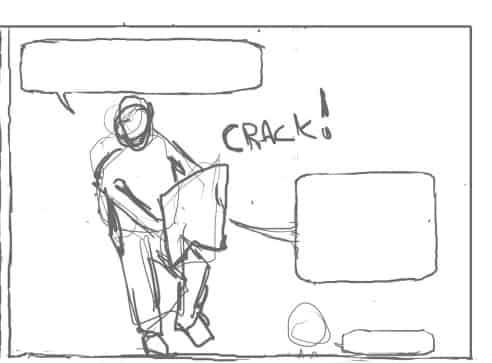
Writing
How to (Mis)Treat Your Collaborators?
It’s a writing cliché when the bad guy is too often punished by someone he victimized. However, we used that formula in “Fifth Man,” where Victor Krugger is killed by the beast he himself created. It’s difficult for an author to avoid this type of shortcut altogether when bringing a story to a close because so many dramatic options have been written over the years.
A Dash of Sex
In a previous entry, we talked about how sexuality entered into our stories. But this isn’t limited to sexual activity; it can play out differently for different individuals. It also offers a new source to draw on for motivations and conflicts between characters. The sexual dimension allows us to make the relationships between characters more complex.
Villains Are Intelligent Too
We’ve already talked about how we want to avoid creating bad guys that fall into the usual clichés. Originally, in “Burst of Energy,” Roslo was supposed to destroy the painting (see image). But Michel Lamontagne again convinced us to revise this part of the story. As he put it, if a bunch of guys go to that much trouble to steal a simple painting, there must be a reason for it. And thus was born Roslo’s decision to have the painting analyzed. 
Listening to the Voice of the Reader
Having been strongly influenced by Marvel Comics, our first stories were rather chaste. But then, one of our friends commented that a group of young people like this one should be “steeped in testosterone.” We thought this made a lot of sense, and this led to the introduction of escorts and gigolos in “Battle at Sea”.
Credibility is in the Details
In “Burst of Energy” initially, Fabien was supposed to switch two paintings, but in the end, he left the lab with the wrong one. Michel Lamontagne explained that this would have been inconsistent with Fabien’s training and personality and therefore, not believable. He suggested that Fabien should leave with both paintings—which, ultimately, is what he tried to do.
Stories That Are Credible, Not Realistic
We’ve already mentioned that our goal isn’t to create realistic stories. Our universe has conventions and if the reader accepts them, he or she will also expect the characters to respect them. Credibility is a challenge because it means constantly reassessing everything, and being open to our collaborators’ comments. While Michel Lamontagne didn’t draw all of “Burst of Energy,” his comments did, in our opinion, add to the narrative’s credibility.
Jean-Pierre Vivian : Painter
Jean-Pierre Vivian is the artist whose work is found in “Burst of Energy.” Originally from France, he has lived in Canada since 1988. He’s always been attracted to different forms of artistic expression. He studied acting; for eight years, he sculpted stone, and for the last 10, he has been painting. His work is characterized by two focuses: a form of minimalism related to the use of white, and the integration of different materials into his canvasses to enrich the rendering. His art naturally explores new impressions. This evolution can be seen in the various solo and group exhibitions in which he has taken part over the last 15 years.
The Issue of Dying
In the last few entries, we’ve been looking at ways of thinking about the death of main characters, and about its dramatic benefits. Of course, if it worked that well, more writers would use it more often. But the problem with death is that it might prevent readers from becoming invested in the story or becoming attached to some characters because they know they might have to mourn them later on down the line.
The Right Amount of Deaths
Like life, death is inevitable, but it must arrive randomly. The reader shouldn’t predict the death of a character. Death should serve as a driving mechanism for the drama, to create new opportunities so that the story can continue to develop. Death should not be used as a means to spice up a bland story.
Story density
Many people bemoan the fact that stories published by Marvel are increasingly fast reads. Authors are now trying to write only what’s essential, and we agree with this approach to scripting scenes. However, one of our collaborators pointed out recently that there are also fewer panels per page, which reduces how much the reader is getting out of reading. Webcomics get around this problem because it offers comic strips for free, which eliminates the issues readers may have with the cost and time involved in reading a strip.


